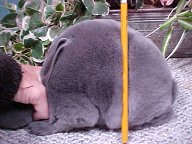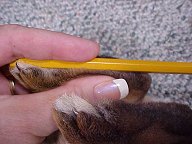

Posing: Set the hind end of the rabbit up first. If you've ever shown horses in a Halter class there is a term they use called squaring up. Well, its the same premise. We are going to square up the rabbit and get his feet under himself. If we don't we can create low shoulders and protruding hips. Shove those hind feet all the way to the front of the rabbit and see where their shoulders are. LOW! Get the toes of the back feet under the hip bone of the rabbit. From the toes up through the hip a pencil or ruler should then hit the highest point of their back. If the highest point of the back is in front of your pencil then the rabbit peaks early. If the highest point is behind the pencil they have long shoulders. If you ever rode a horse, when the instructor got you up in that saddle they told you to sit up straight. To keep your toes in the stirrups in line with you knees. Imagine a string through your body pulling you up straight and keeping you in balance in that saddle. If you lean back you lose that balance and will fall out of the saddle. If you lean forward you'll bounce out of your saddle and land on the horses neck! EVERYTHING is about this premise called BALANCE:
This is a junior doe slated for show row- Pictures 1 and 2 show how I test ears to see if they are in balance with her body- they need to be shorter than her head. They are, so she passes this test. If they are even with the end of the nose or longer, I usually move them on as pets.


In Picture 3 we see the pencil laid across her back horizontally - she is in a
properly posed position. The highest point of her back is higher than her
ears- Good, that's what we want! When posing always have all FOUR FEET flat on the ground- no tippie toes or it throws the whole thing out the window! 
In this photo we see an 8 week old junior doe junior that has 3" ears, since she does not have the depth to balance those ears she will be slated for the pet market

In picture 4 we have the pencil in a vertical fashion. Place it even with the toes of the hind foot which should be directly under the hip-you want to be sure that the highest point of her back and hip are over the end of the toes of her hind foot. Good, she passes this test too! I like this doe!

These two rabbits peak early or in front of pencil- see what happens to their rear ends- they fall away and slope off - Caution: Juniors learning to pose tense up and freeze their muscles and push forward- get them to relax and make sure they aren't just tense before you cull. I pick them up and let the rabbit slide out of my hands and back to the table several times to relax and loosen them up then try reposing My red doe, NIKI, looked like her hind end really sloped off when she was young and my husband wanted to cull her- but I hung on to her and 14 Legs later I like to tease him about it!! (she grew up and no longer tensed those muscles up) .


These pictures show the finger test. First we test balance of width to depth - the width between the hind legs should be at least 3 fingers wide- they should not be cow hocked- if you feel those hocks hitting your fingers there could be a problem. In the second test the rabbit should have one finger width between the bone of the ribs and the bone of the hips- if you can get more fingers in between those bones, the rabbit is too long in the mid-section.


In these two pictures we are testing balance of length of leg to length of stomach- which interestingly enough should be the same-- we measure the length of the hind foot from the hock to the toes. I then mark it on my pencil and then measure the length of the underside of her stomach- measure the flat part from the bone of the front leg to the hip bone or beginning of the hind leg. They are equal - good! This rabbit is in balance. I usually find that the ones that are well balanced as juniors stay that way and don't go through a lot of different, gawky growing stages. I like to wait until they are 16 weeks to show them so that junior prime coat is in and they look good. They should be done growing and in balance by 16 weeks!


In these photos we have a blue junior doe that is long in body and shoulders- to demonstrate this we can easily put 2 fingers between her rib cage and hip bone- then we see a side view on her- she's not very deep and looks long-- and in the last picture we do the test on the underside- her belly length is much longer than her hind foot by a good 3/4" of inch- I have a hard time holding the pencil and doing the photographs so bear with me as to the exact placement of everything- but if you understand the premise and can do it at home we have achieved our goals!



In the next set of pictures, we have a Gan doe- this line tends to throw some longish ears which come from a few of the deep, but awesome does in that line- this doe and her sister have 3 1/2 ears but look at what depth she has! I tested her ears and they are shorter than her head (her ears would never fit on that jr. castor doe-as her head is little) but her ears fit her body- see the depth- the arch of his back is higher than the ears- a Judge will look at this doe and see a nicely balanced animal- When it comes time to breed her I will use a little buck with short ears like NAM!


This is an example of how not to pose a rabbit- its feet are pushed too far forward- they should be lined up under its hipbone- see what happens- the hind end looks undercut and the shoulders dip down behind the neck. Now pose that animal right and I bet he's great looking! Take an animal and pose it both ways and see the difference- take pictures and study them! Pictures are unmistakably the best way to see the difference a good and bad pose makes- they also help to see the rabbit clearly- I miss many things I always catch on the photo!
